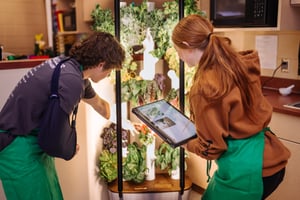The Role of Mindfulness in Modern Education In the fast-paced world of education, the inclusion of...
Hydroponic Gardyning in Classrooms: A Game-Changer for STEM
Revolutionizing STEM Education with Hydroponics
Hydroponic gardening is making waves in the educational sector, particularly within STEM (Science, Technology, Engineering, and Mathematics) programs. By integrating this innovative technology into classrooms, educators are discovering new ways to engage students and foster a deeper understanding of scientific concepts. As Alicia Kuntz, a seasoned science educator, noted during a recent webinar, "Having Gardyn in our classroom has honestly been the best move I think I have ever made in my career."
The introduction of hydroponic systems in education is not just about growing plants without soil; it's about cultivating curiosity and critical thinking skills. These systems provide a tangible and relatable context for students to explore complex scientific principles, from plant biology and ecology to chemistry and physics. The ability to witness the growth process firsthand makes learning more interactive and impactful, as students are more likely to retain and apply the knowledge they acquire.
The Benefits of Hands-On Learning in Science
Hands-on learning is a powerful educational approach that enhances student engagement and understanding. Hydroponic gardening systems offer a unique opportunity for students to gain practical experience in science. Renee Egan, another experienced educator, shared her enthusiasm during the webinar: "I was trying to get a way for my students to have more hands-on learning to keep them invested in the class."
This approach allows students to develop essential skills such as observation, analysis, and problem-solving. By managing their hydroponic gardens, students learn to take responsibility, collaborate with peers, and apply scientific methods to real-world challenges. The direct interaction with living organisms also helps students develop a sense of empathy and environmental stewardship, fostering a lifelong appreciation for nature and sustainability.
How Hydroponic Systems Simplify Classroom Gardening
One of the standout features of hydroponic systems is their simplicity and ease of use, making them ideal for classroom settings. Devices like Gardyn are AI-powered, featuring a technology called Kelby that automates much of the gardening process. Alicia highlighted this benefit, saying, "I know the lights are going to come on their own. I know it's going to water on its own."
These systems are designed to be compact, requiring minimal space, and can be easily adapted to different educational levels and curricula. With a vertical design, they utilize limited classroom space efficiently, allowing educators to integrate them into various learning environments. The minimal maintenance required also means that students can focus more on learning and less on the technicalities of plant care.
Engaging Students with Innovative Technologies
The integration of AI and other advanced technologies in hydroponic systems is reshaping how students interact with science. Through the use of AI-powered cameras and time-lapse functionalities, students can monitor plant growth and receive real-time feedback on their gardening efforts. This technology not only enhances the learning experience but also introduces students to cutting-edge tools and methodologies.
Educators like Renee have found that these technologies captivate students' attention and inspire them to explore further. "Students love that it has all those different features with it as well," she mentioned. By engaging with these technologies, students develop digital literacy and technical skills that are increasingly valuable in today's tech-driven world.
Real-World Applications of Classroom Hydroponics
Hydroponic gardening in classrooms goes beyond theoretical knowledge, offering students a glimpse into real-world applications. During the webinar, educators shared examples of projects involving NASA and other scientific organizations, where students tested novel crops for space missions. Alicia's experience with seeds from the International Space Station underscores the potential for these projects to connect classroom learning with global scientific endeavors.
These real-world applications provide students with a broader perspective on the importance of science and technology in addressing global challenges such as food security and sustainability. By participating in hydroponic projects, students can see the tangible impact of their work, motivating them to pursue careers in STEM fields and contribute to innovative solutions.
Future Prospects of Hydroponics in Education
The future of hydroponics in education looks promising, with the potential to revolutionize how science is taught and learned. As more educators recognize the benefits of this approach, hydroponic systems are likely to become a staple in classrooms worldwide. They offer a versatile platform for interdisciplinary learning, integrating topics such as biology, chemistry, engineering, environmental science, and even health & wellness.
The ongoing development of hydroponic technologies, coupled with the growing emphasis on sustainability and STEM education, suggests that these systems will play an increasingly significant role in shaping the next generation of scientists and engineers. As Alicia and Renee demonstrated, the enthusiasm and dedication of educators are crucial in driving this transformation, ensuring that students are equipped with the knowledge and skills needed to thrive in an ever-evolving world.
Curious how to include Gardyn's hydroponics in the classroom? Watch our replay with Alicia Kuntz and Renee Egan in our "Introduction to Hydroponic Gardyning".


